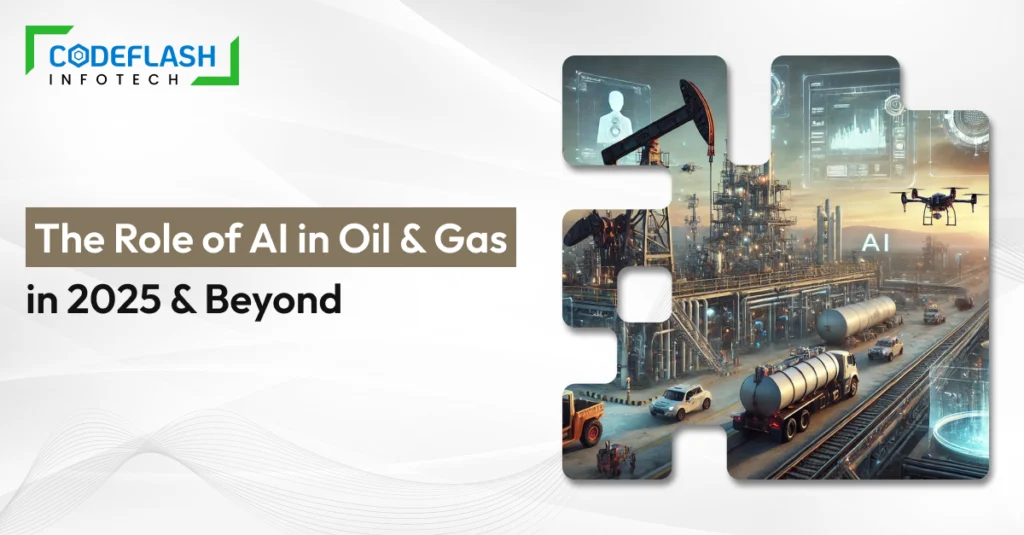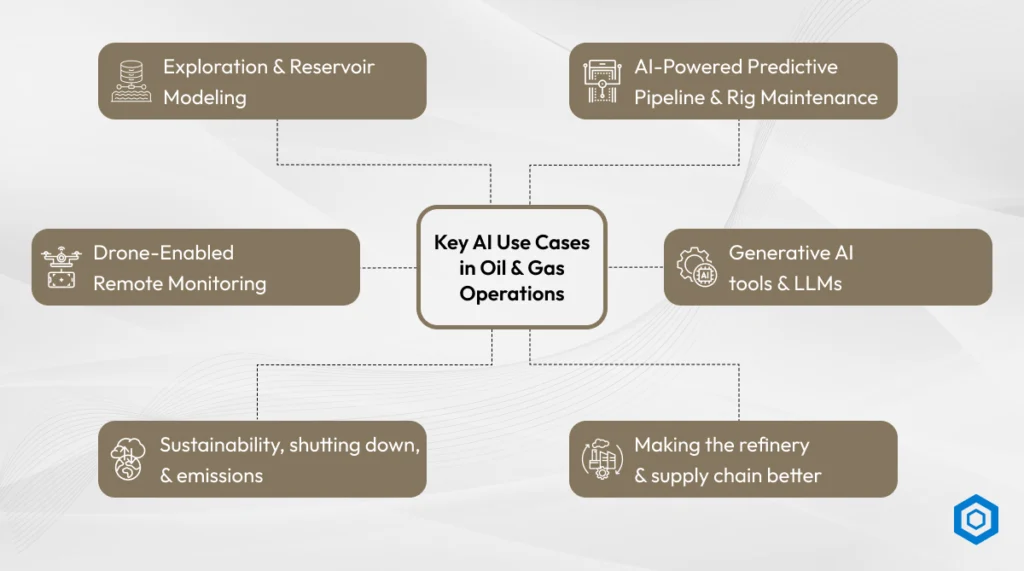
The Role of AI in Oil and Gas in 2025 and Beyond
01 August
How AI is transforming oil and gas operations in 2025?
The Role of AI in Oil and Gas is rapidly evolving—from being a supporting tool to becoming a strategic game-changer. As we move through 2025 and beyond, AI is transforming every stage of the industry, including exploration, drilling, predictive maintenance, emissions control, and even decommissioning operations.
This change makes AI not only a tool for making things more efficient, but also a key part of changing how things work. As per statista says that the global market for artificial intelligence will expand to more than $1.8 trillion by 2030. This means that companies in many fields, including oil and gas, are quickly investing in it.
The Role of AI in Oil and Gas is evolving rapidly, with more individuals recognizing it not just as a task-simplifying tool but as a transformative force reshaping industry practices. This blog explores how the U.S. market is experiencing AI-driven advancements in operations, sustainability efforts, and maintenance optimization across oilfields, refineries, and pipelines.
We will cover the Role of AI in Oil and Gas industry in 2025, use cases, recent advancements, potential return on investment, and the challenges companies encounter when scaling AI solutions for the energy sector.
There is considerable pressure on the energy industry to be cleaner, leaner, and more efficient. The use of AI has grown in importance during this transition.
It enables oil businesses to make real-time, more informed decisions that reduce emissions and maximize production efficiency. U.S. businesses are increasingly utilizing AI.
- Reducing expensive downtime requires predictive maintenance.
- There is a growing emphasis on tracking carbon emissions and reducing them.
- To reach the aim of enhancing the overall quality of exploration, it is important to do a thorough analysis of the complex data that is connected to the subsurface.
- Using Intelligent automation for oil companies can help enhance labor and safety.
Read more: How to Re-evaluate Your Frontend Architecture and Improve Its Design.

Key AI Use Cases in Oil and Gas Operations
1. Exploration & Reservoir Modeling
Geophysicists are using AI algorithms to analyze seismic data and geological models more quickly and accurately. Machine learning models enable companies to identify optimal drilling locations and enhance recovery rates by simulating the behavior of reservoirs.
Digital twins, which are virtual representations of subsurface environments, are expected to be used more frequently by oil and gas companies by 2025 to test drilling techniques without posing a risk to human safety.
2. AI-Powered Predictive Pipeline and Rig Maintenance
If offshore rigs or pipelines break down, it could cost millions of dollars. AI-powered predictive analytics finds problems with equipment before they happen, allowing for preventive maintenance.
Businesses can avoid shutdowns by proactively replacing components based on AI-based predictive maintenance in oil rigs, temperature, vibration, and failure history.
3. Drone-Enabled Remote Monitoring
Drones equipped with AI continuously monitor flares, spills, and pipelines across all locations. Drones perform these tasks. When used in conjunction with computer vision, these drones can access dangerous or hard-to-reach places and immediately send alerts when problems arise. Such functionality is safer for people and saves time.
Businesses can save money on inspections and ensure compliance with regulations using AI-powered remote monitoring systems.
4. Generative AI tools and LLMs
Engineers can now quickly get information from generative AI tools that can read thousands of safety manuals, technical documents, and reports. LLMs like GPT-4 are becoming increasingly proficient in understanding oil and gas terminology, enabling them to assist with design optimization, failure analysis, and even facilitating the hiring of new workers.
5. Sustainability, shutting down, and emissions
It is easier to detect methane leaks and greenhouse gas emissions in real time with AI. Several businesses, like ADNOC, assert that AI-driven optimization has resulted in a value that is greater than $500 million. The US is also utilizing AI models to develop more efficient shutdown plans. In the long run, it saves money and provides some environmental relief.
6. Making the refinery and supply chain better
AI is helping refineries operate more efficiently by identifying issues, managing processes, and automating tasks in real time. AI helps keep track of spare parts and determine the logistics required. This approach helps ensure that time and resources are utilized efficiently in the workplace.
AI-powered logistics solutions are becoming increasingly crucial in the energy industry for enabling real-time decision-making based on data.

What are some ways AI can help oil and gas companies?
The Role of AI in Oil and Gas goes beyond solving existing challenges—it’s driving innovation across the industry. By leveraging intelligent automation and predictive analytics, AI is enabling oil companies to generate new ideas, boost safety, improve productivity, and maximize profitability.
1. Operational Efficiency
AI helps things run more smoothly by reducing the likelihood of human error, monitoring production rates, and optimizing drilling schedules. Machine learning algorithms analyze real-time data collected by numerous sensors. The result makes it easier to make decisions that evolve, which, in turn, helps streamline workflows.
2. Better Safety
Wearable AI-enabled devices can significantly reduce the risk of accidents by monitoring employees’ health and alerting managers to potential hazards.
3. Reduced Downtime
AI-based predictive maintenance in oil rigs enables businesses to monitor rotating equipment, such as pumps, turbines, and machines, and anticipate when they are likely to fail. This helps extend the asset’s lifespan by allowing repairs to be made when damage is minimal.
4. Sustainability Gains
AI helps the environment a lot by finding and fixing methane leaks before they become worse. By modeling their energy usage and emissions of pollution, businesses can meet their ESG goals and comply with regulations.
A key part of starting an AI solution for the energy sector
Your AI project in the oil and gas industry will be a success if you do these three straightforward things:
1. Ensure the operation is ready
First, identify the areas that could benefit the most from AI. Drilling optimization, emissions management, and predictive maintenance are a few examples. To determine what you need to support AI systems, examine your current data infrastructure, integration capabilities, and available talent.
2. Choose the right partner
Choose a use case that matches with your business goals and gives you benefits right away. Get help from AI development experts who know a lot about both the technical side of things and the energy business. The result makes it easier to use and speeds up the return on investment (ROI).
3. Start Small, Then Grow
Please ensure that your pilot program includes well-defined KPIs. Use the pilot to refine your model, learn from it, and get everyone in your company on board. Once it works, roll it out to other departments or facilities with more confidence and speed.
What Can AI Do to Help the Oil and Gas Industry?
Artificial intelligence will revolutionize how the oil and gas industries work in 2025. It speeds up decision-making, makes it more accurate, and helps you think ahead. AI allows the entire value chain to work more efficiently digitally, from extending asset lifecycles to reducing carbon footprints.
- AI algorithms analyze extensive data from rigs, pipelines, and refineries to provide teams with valuable insights that enable them to make decisions more quickly and accurately.
- AI can detect when critical machines are likely to malfunction, enabling timely maintenance and minimizing downtime. AI can also make drilling, refining, and distribution more efficient, which saves money and reduces carbon footprints.
- Better Exploration is an AI model that utilizes seismic data, satellite images, and geological information to identify potential reservoirs with greater accuracy.
- Safety at Work with AI-powered remote monitoring tools and sensor networks detects hazardous situations early, helping to keep field workers safe.
- It assists in predicting demand and managing logistics, ultimately boosting the overall efficiency of the supply chain.
Significant Challenges of Deploying AI solutions for the energy sector
AI has the potential to completely remake the oil and gas sector, but putting it into practice is not simple. Businesses must address the following significant challenges:
1. Old Infrastructure
Many oil and gas facilities still use equipment that protects against AI. You typically have to overhaul your entire infrastructure or invest significantly in middleware solutions to use AI.
2. Data Quality and Fragmentation
AI works best when the data is well-organized. However, siloed, incomplete, or inconsistent data across all production stages makes life difficult for many operators. It takes a considerable amount of time to clean and combine data.
3. Not enough skilled workers
There aren’t enough people in the field who possess both AI and oil and gas expertise. To fill this gap, people often require extensive training in various fields or must hire expensive consultants.
4. Costs of Implementation
Setting up AI requires a significant upfront investment in infrastructure, data management systems, AI development, testing, and ongoing maintenance. Due to this, investing is challenging for small and medium-sized enterprises.
5. Resistance to Change
Companies may not use AI and automation tools as much if their culture doesn’t support them. Field workers may not trust AI suggestions, and managers may not want to change processes that have been in place for a long time.
6. Online Security Concerns
The attack surface expands as AI connects and controls more devices. Firm cybersecurity plans for AI are essential because they protect digital assets from cyber threats.
Read More: Key Steps To Implement DevOps Strategy In Your Organization
Various oil and gas AI applications
AI is being utilized in multiple ways by the oil and gas industry to facilitate a shift from digital to physical operations across all areas, from upstream to downstream.
1. Machine Learning
These models are often used to analyze seismic data, make predictions about how reservoirs will behave, and identify the optimal drilling paths. ML also helps protect assets by looking for signs of corrosion or wear and tear on equipment.
2. Vision for Computers
This type of AI is beneficial for visually inspecting pipelines, offshore rigs, and machinery. It analyzes images and videos automatically, finding flaws or leaks faster than human inspectors and making data more accurate.
3. Natural Language Processing (NLP)
Engines extract essential information from unstructured data sources, such as technical manuals, drilling logs, and incident reports. This gives engineers more time and helps them make better choices.
4. Generative AI
By generating new engineering designs or more effective maintenance plans, generative AI in energy sector helps reduce costs and expedite work. It can also simulate how people would react to an event or model different situations in a reservoir.
5. Edge AI and IoT Integration
AI algorithms can be used on rigs, in pipelines, or at the edge to make decisions even when there is no internet connection. This is especially helpful in areas that are difficult to access or hazardous, where real-time processing is necessary.
What Can AI Do to Help the Oil and Gas Industry?
In the next few years, the use of artificial intelligence in the oil and gas industry will increase. Companies will shift from using AI for routine tasks to exploiting it to set themselves apart from their competitors. Future events include:
1.Managing Carbon
AI models will help companies better track their emissions, optimize flaring operations, and develop the most effective carbon capture plans for each site. This will help the world achieve its goals for reducing carbon emissions.
2. Autonomous Operations
Next-generation AI systems will be able to operate entire offshore rigs and refineries with minimal human intervention. AI and robots will work together to drill, check things, and follow emergency procedures on their own.
3. Predictive Decommissioning
AI will play a significant role in determining when to retire old assets. Models will assess the pros and cons of cost and risk, run simulations to predict how the environment will be affected, and suggest the best times and methods for shutdown.
4. AI + Renewable Energy Integration
As oil and gas companies expand, AI will help them strike a balance between their traditional operations and new sources of energy, such as wind, solar, and hydrogen. Being able to store energy and figure out how much is needed in real time is really significant.
5. AI-Powered Talent Development
AI-powered digital twins and VR training modules will help workers learn new skills faster. AI will find out what people don’t know and create training paths for jobs in safety, maintenance, and compliance.
Find out more: How AI will change the way we build infrastructure and get energy.
Conclusion
The Role of AI in Oil and Gas is no longer just about adopting the latest technology—it’s about reshaping the future of the energy sector. As we move into 2025, the Role of AI in Oil and Gas is becoming central to making operations safer, more cost-efficient, sustainable, and overall more optimized.
From exploration to production, the Role of AI in Oil and Gas is influencing every stage by introducing intelligent automation, real-time data insights, and predictive maintenance. Companies that recognize the Role of AI in Oil and Gas and invest in smart, scalable AI solutions will gain a significant edge in this fast-evolving market.
Embracing the Role of AI in Oil and Gas isn’t just about solving today’s challenges—it’s about future-proofing operations for a smarter, more sustainable energy industry.
Codeflash Infotech enables energy organizations that want to stay ahead of the curve with AI technologies that can help them address significant issues, such as smart automation, pollution detection, and proactive maintenance planning. These AI solutions for the energy sector were designed to address these challenges.
Are you prepared to utilize AI to enhance your energy business operations? Are you ready to go on? We’ll take care of everything else if you get in contact with us right away.

Frequently Asked Questions
AI is used for predictive maintenance, tracking emissions, real-time monitoring, and exploration modeling to save money and improve operational efficiency.
AI utilizes data from the present to automate tasks that people typically perform, facilitate better decisions, predict when machines will malfunction, and enhance safety.
It helps prevent machines from breaking down, reduces downtime, extends their lifespans, and lowers the cost of repairs.
Look for a high-impact area where AI can make an immediate, significant difference, such as tracking emissions or predictive maintenance. After that, hire AI development company that knows the energy sector and has a lot of experience to help you with your pilot project and make sure it will work in the long run.
Table of Content
How AI is transforming oil and gas operations in 2025?
Key AI Use Cases in Oil and Gas Operations
What are some ways AI can help oil and gas companies?
A key part of starting an AI solution for the energy sector
What Can AI Do to Help the Oil and Gas Industry?
Significant Challenges of Deploying AI solutions for the energy sector
Various oil and gas AI applications




